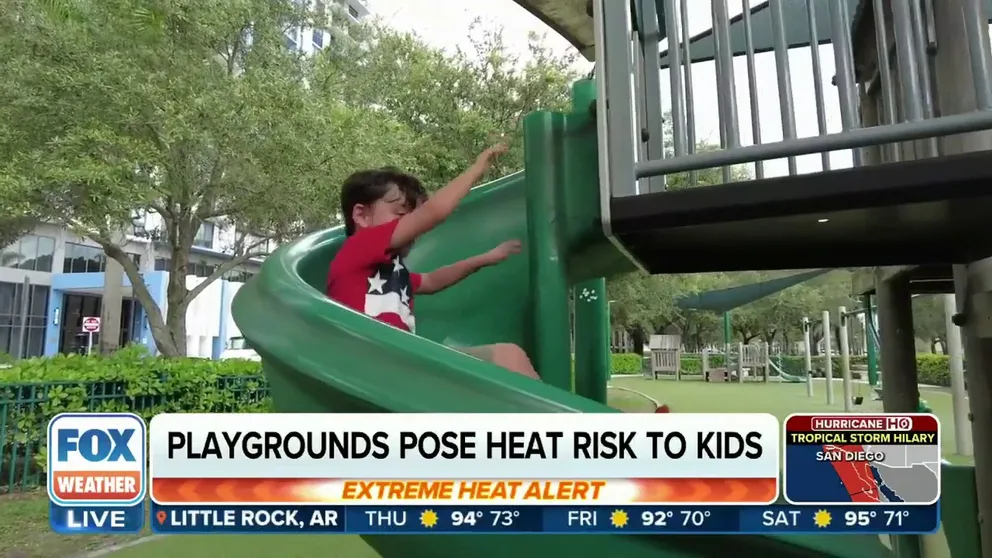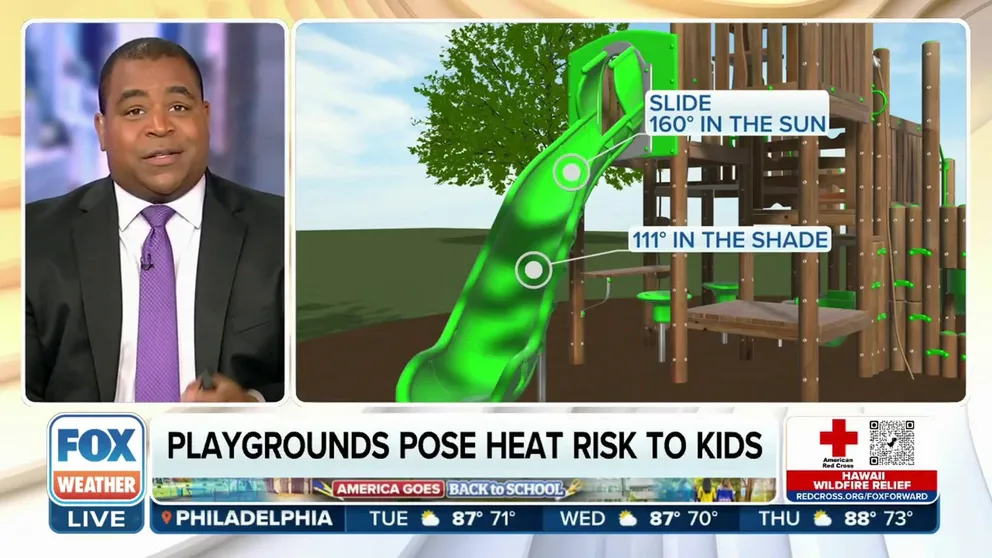Hot playground danger: Kids could get third-degree burns from equipment
Playgrounds turn dangerous in the heat. Slides, swings and benches heat up and temperatures over 118 degrees can cause a first degree burn. Temperatures over 131 can cause a second degree burn. FOX Weather hit the park to take temperatures of our own.
Hidden danger: Playgrounds hot enough to burn kids
FOX Weather's Brandy Campbell takes us to a playground on a cloudy day and finds out the equipment gets hot enough to cause second and third degree burns to unsuspecting kids.
When intense summer heat scorches your area, it can be a dangerous experience for kids on playgrounds baking in the intense sun. FOX Weather hit the playground to find out exactly how hot the swings, slides and benches actually get. Our expert was even surprised by how hot the equipment got on a cloudy day.
"There's some knobs for the kids to grab, and I'm getting some temperatures here of 118 to 125 degrees," Lieutenant Kristian Garcia of the Miami-Dade Fire and Rescue Department said as he ran his thermal gun over the surface. "Today's cloudy, so the temperature should have exceeded 140 on a regular hot, sunny day."
How hot is the equipment?
He found the artificial turf at 145 degrees, the swing at 119 degrees and a kid's bench over 130 degrees. The air temperature was only 91 at the Miami playground.
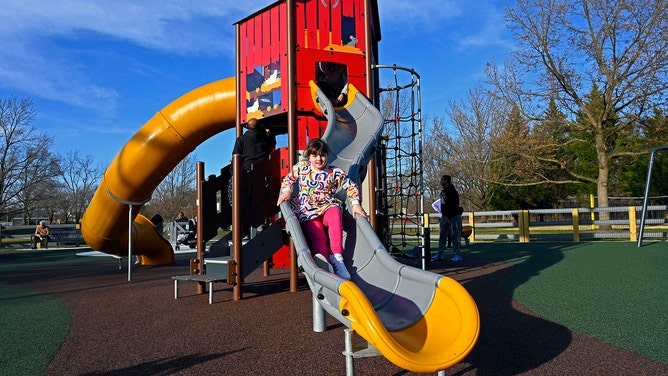
File: A girl playing on a playground slide.
(Kenneth K. Lam/Baltimore Sun/Tribune News Service / Getty Images)
Unsuspecting kids who flock to playgrounds and during recess don't realize the hidden danger. And children are more susceptible than adults to burns, according to the Royal Children's Hospital.
Even surfaces currently in the shade can be hot. Dark-painted surfaces and metal retain heat. This table below was 149 in the sun. Garcia then took the temperature in the shade. The surface was still 125 degrees, hot enough for a first-degree burn.
HOW TO TELL THE DIFFERENCE BETWEEN HEAT EXHAUSTION AND HEAT STROKE
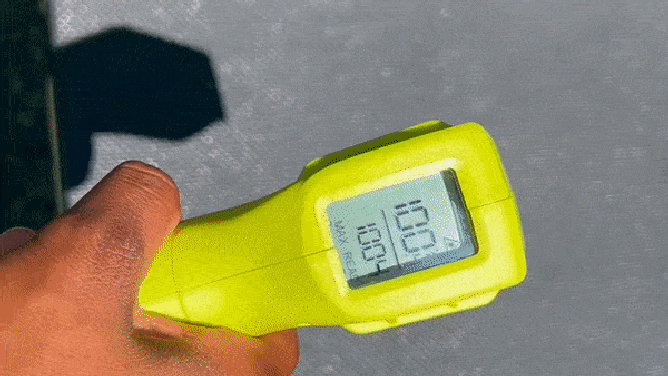
Playground equipment in the sun soars to 149 degrees while the same surface in the shade is 125. The air temperature is 90.
(Brandy Campbell / FOX Weather)
FOX Weather's Jason Frazer looked into how much hotter common play surfaces get in the sun versus the shade on a 100-degree day:
- Rubber surface: 107 in shade, 188 in sun
- Grass: 88 in shade, 104 in sun
- Slide: 111 in shade, 160 in sun
- Handrails: 104 in shade, 120 in sun
- Playground steering wheel: 104 in shade, 120 in sun
Heat dangers on the kids' playground
Meteorologist Jason Frazer shows us how hot some common playground equipment can get in the sun.
Blacktop surfaces and asphalt get even hotter in the sun. A study by researchers at the Wuhan University of Technology in China found that asphalt pavement is generally 75 degrees warmer than the air temperature.
That means the 90-degree day in Miami could net blacktop temperatures of 160 degrees. The blacktop at Frazer's park on a 100-degree day could reach 175 degrees, which means instantaneous burns.
How hot is too hot for kids?
The National Institute of Standards and Technology posted the following skin temperatures and the associated damage:
- 111 degrees: Kids feel pain
- 118 degrees: First-degree burn
- 131 degrees: Second-degree burn with blistering
- 140 degrees: Burned tissue becomes numb and susceptible to more burning
- 162 degrees: Skin tissue is instantly destroyed
Most adults will suffer third-degree burns at 150 degrees for 2 seconds or 130 degrees for 6 seconds, according to the Arizona Department of Child Services.

File: A child with a first degree burn.
(BSIP/UIG / Getty Images)
Types of burns
A first-degree burn only damages the outer layer of skin, the epidermis. It is painful, red, dry, without blisters, and rarely means long-term damage, according to Johns Hopkins Medicine.
Second-degree burns damage the epidermis and part of the dermis layer. A superficial second-degree burn is painful, blisters and may scar. Blisters may weep, leaving the skin open to infection. Deeper second-degree burns are less painful because the nerves are damaged. They will form more scars and weeping blisters, according to a study published in the journal Nature Reviews Disease Primers.
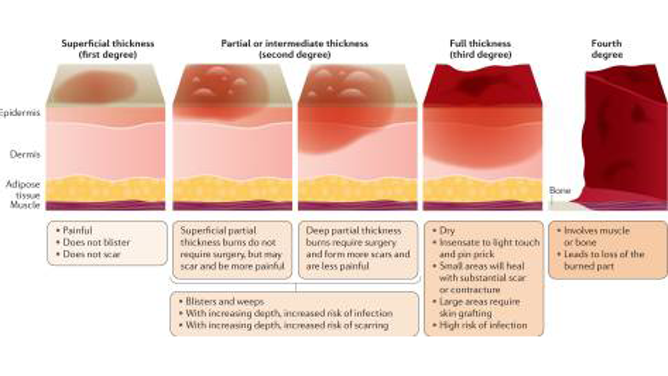
The difference between first second and third degree burns is the depth of damaged skin.
(Burn Injury study, Marc Jeschke et al. / FOX Weather)
A third-degree burn destroys both the epidermis and the dermis. The site is dry and numb because the nerve endings are destroyed.
Parents and teachers should take caution to prevent injury
Garcia agrees that most parents and teachers won't have a thermal gun at the playground. But, there are some easy steps and cautions that they should take before letting the kids play.
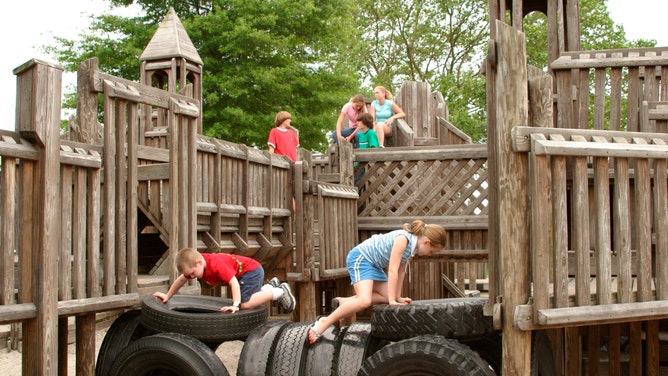
File: Children playing on a playground.
(Jeffrey Greenberg/Universal Images Group / Getty Images)
"We could simply put our hands over these possible hot surface areas. If we have toddlers, maybe take a knee and feel the surface of the Astroturf," Garcia suggested. "We could scan the playground and possibly tell the kids, ‘Hey, these surfaces are going to be hot,’ or we could avoid these playgrounds in the middle of the day."
He suggests hitting the playground in the early morning or after a rain shower.
Some school districts have heat plans. The Miami-Dade School District said that they stop outdoor activities when the thermometer hits 92.
